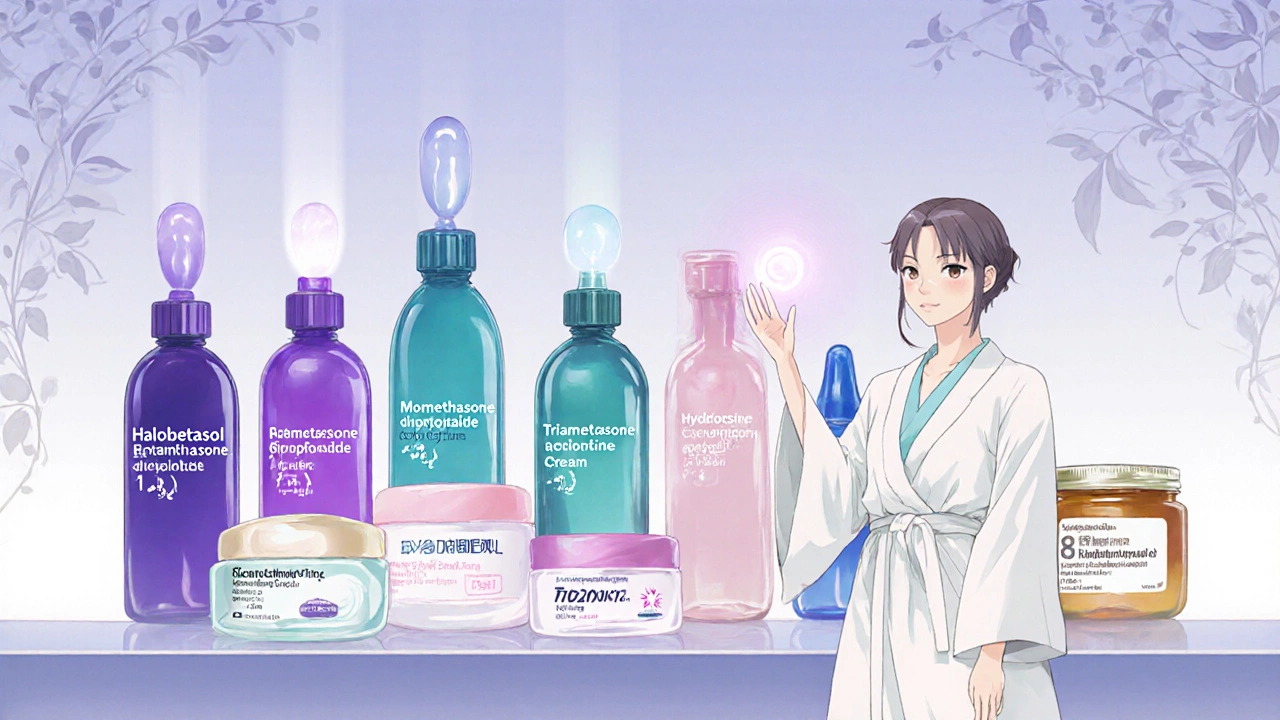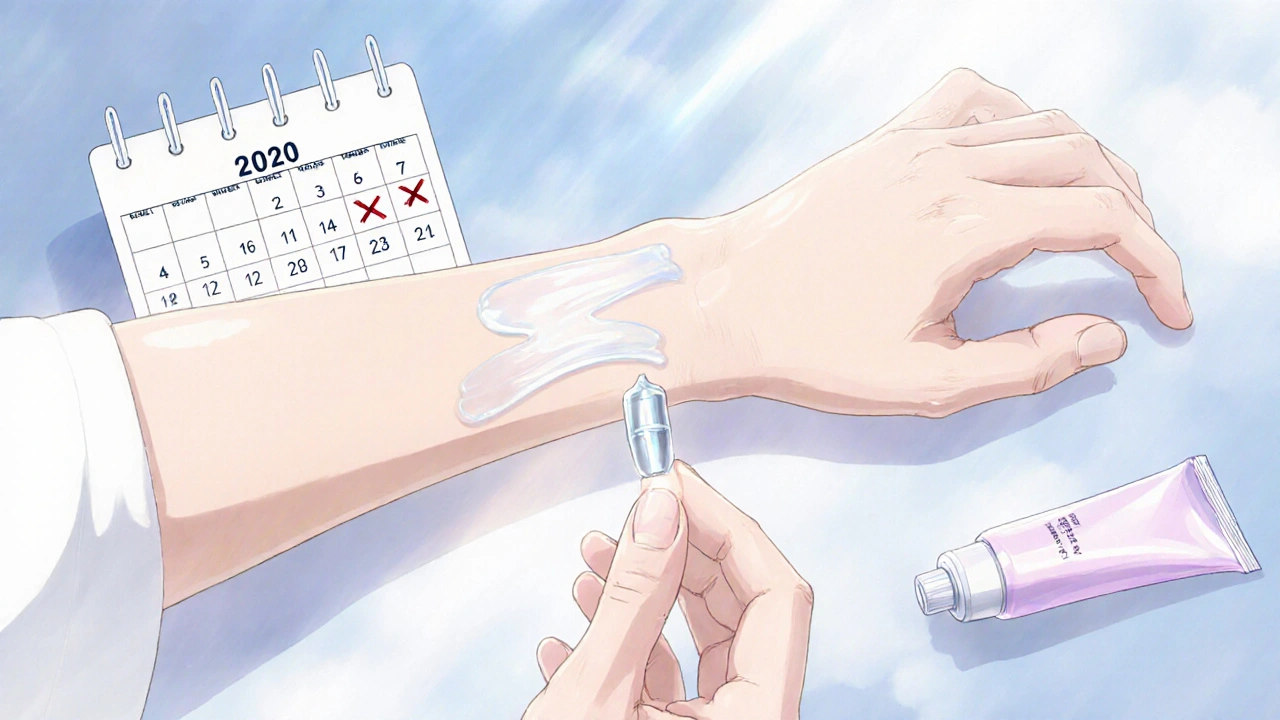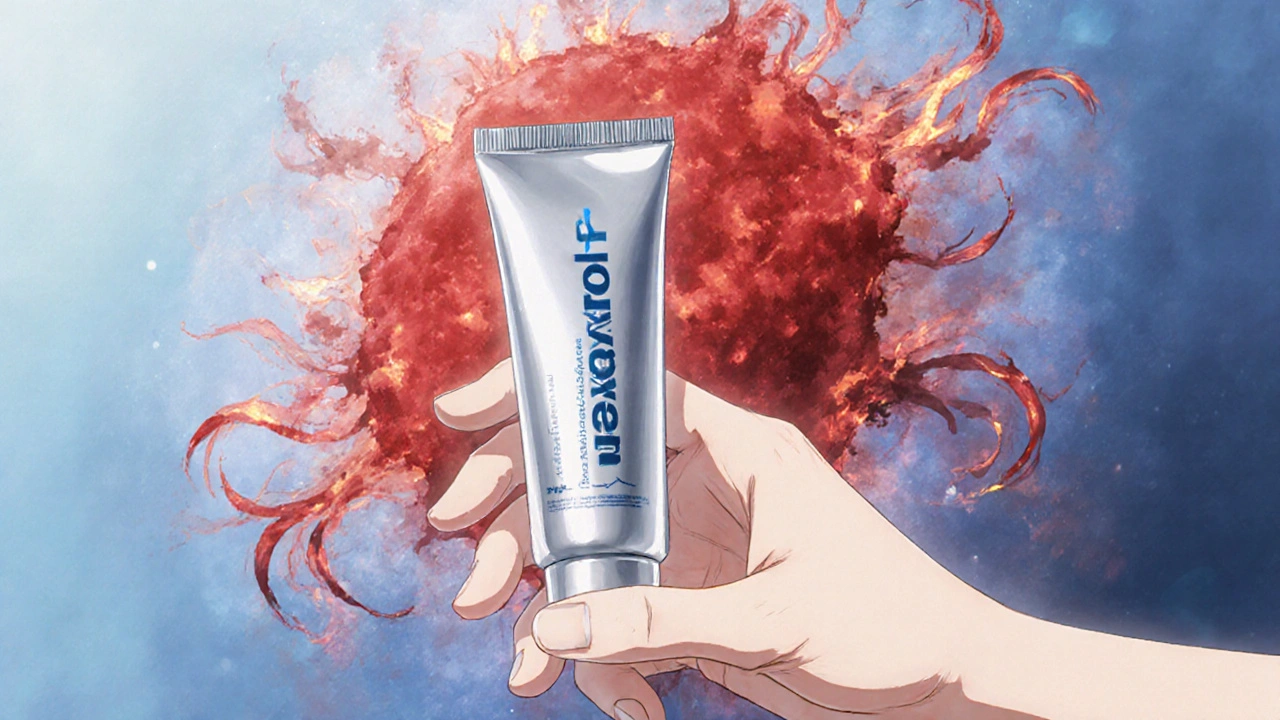Steroid Potency Decision Tool
Choose Your Condition
Recommended Treatment
Select your condition parameters to see recommendations
When a dermatologist prescribes a super‑potent steroid, most patients recognize the brand name Temovate (Clobetasol) is a high‑strength topical corticosteroid used for stubborn inflammatory skin conditions. The drug works wonders, but its strength also raises questions about safety, cost, and whether a milder option could do the job. This guide lines up the most common alternatives, breaks down potency, side‑effects, and typical use‑cases, and helps you decide which cream-or ointment-fits your skin’s needs best.
Key Takeaways
- Temovate (Clobetasol) is a class‑IV (super‑potent) steroid; alternatives range from low to high potency.
- Halobetasol and Betamethasone dipropionate match Temovate’s strength but differ in formulation and cost.
- Mometasone furoate and Triamcinolone acetonide provide medium potency for easier tapering.
- Non‑steroidal options such as Calcipotriene or Tacrolimus avoid steroid side‑effects but may act slower.
- Choosing the right product depends on diagnosis, treatment duration, skin type, and doctor guidance.
What is Temovate (Clobetasol)?
Temovate’s active ingredient is clobetasol propionate, a synthetic corticosteroid approved by the FDA in 1979. It belongs to the class‑IV category, the highest potency tier for topical steroids. In plain terms, a pea‑sized amount can suppress severe eczema, psoriasis plaques, or lichen planus where milder creams have failed.
How Temovate Works and When It’s Used
The drug mimics cortisol, the body’s natural anti‑inflammatory hormone. By binding to glucocorticoid receptors in skin cells, clobetasol reduces the release of cytokines, limits immune cell migration, and tightens blood vessels. The net effect is rapid redness and itching relief.
Typical indications include:
- Chronic plaque psoriasis that resists lower‑potency steroids.
- Severe atopic dermatitis flares on thick skin (e.g., palms, soles).
- Lichen planus, discoid lupus, and other autoimmune dermatoses.
- Hyperkeratotic lesions where deeper penetration is needed.
Because of its strength, doctors usually limit use to 2‑4 weeks, then taper to a milder steroid.

Top Alternatives at a Glance
| Active Ingredient | Potency | Typical Indications | Prescription Status | Common Side Effects |
|---|---|---|---|---|
| Clobetasol propionate | Super‑high (ClassIV) | Severe psoriasis, stubborn eczema, lichen planus | Prescription | Skin atrophy, telangiectasia, HPA‑axis suppression |
| Halobetasol propionate | Super‑high (ClassIV) | Psoriasis, chronic dermatitis, scalp conditions | Prescription | Similar to clobetasol, slightly lower systemic absorption |
| Betamethasone dipropionate | High (ClassIII‑IV) | Eczema, psoriasis, alopecia areata | Prescription | Skin thinning, stretch marks, potential adrenal impact |
| Mometasone furoate | Medium‑high (ClassIII) | Atopic dermatitis, contact dermatitis, mild psoriasis | Prescription (some OTC low‑dose) | Less skin thinning, occasional burning |
| Triamcinolone acetonide | Medium (ClassIII) | Eczema, insect bite reactions, seborrheic dermatitis | Prescription (some OTC low‑strength) | Minimal atrophy when used short‑term |
| Hydrocortisone 1%‑2.5% | Low (ClassVII‑VIII) | Mild irritations, diaper rash, minor eczema | OTC | Very low risk of systemic effects |
| Calcipotriene (Vitamin D analog) | Non‑steroid | Plaque psoriasis (as monotherapy or combo) | Prescription (OTC in some formulations) | Local irritation, rarely hypercalcemia |
| Tacrolimus ointment | Non‑steroid | Atopic dermatitis, facial eczema | Prescription | Burning sensation, possible increased skin infection risk |
Deep Dive into Each Alternative
Halobetasol propionate
Halobetasol is the only other FDA‑approved ClassIV steroid. It’s often sold as a foam, which can spread easier over scalp or hair‑bearing areas. Studies show its systemic absorption is a tad lower than clobetasol, making it a modestly safer choice for larger surface areas.
Cost‑wise, generic halobetasol can be 15‑20% cheaper than brand‑name Temovate, but insurance coverage varies.
Betamethasone dipropionate
Betamethasone straddles the high‑potency line. It’s available as creams, ointments, and lotions, giving clinicians flexibility for body vs. scalp. Some dermatologists prefer it for patients who need strong action but are wary of clobetasol’s reputation for skin atrophy.
Real‑world data from a 2023 multicenter trial found comparable eczema clearance rates between betamethasone dipropionate 0.05% and clobetasol 0.05% after 2weeks, with slightly fewer reports of telangiectasia in the betamethasone group.
Mometasone furoate
Mometasone is a go‑to medium‑high steroid when you want strong relief without jumping straight to ClassIV. It’s especially popular for facial eczema because the risk of thinning skin is lower.
For chronic plaque psoriasis, mometasone often serves as the “step‑down” from clobetasol after the initial 2‑week burst.
Triamcinolone acetonide
Triamcinolone offers a balanced potency that works well for acute flare‑ups, insect bites, or mild-to‑moderate dermatitis. It’s available in ointment and spray forms, which some patients find less greasy.
Because it’s less likely to cause HPA‑axis suppression, doctors sometimes keep a 0.1% triamcinolone bottle in the office for quick rescue therapy.
Hydrocortisone (Low‑potency)
Hydrocortisone 1%-2.5% is the over‑the‑counter (OTC) staple. It’s great for minor irritations-think diaper rash or a mild sunburn-but it won’t move the needle on severe psoriasis.
Its safety profile is excellent: virtually no risk of systemic effects, even with daily use over large areas.
Calcipotriene (VitaminD analog)
Calcipotriene isn’t a steroid at all. It works by normalizing skin cell growth, which is why it’s effective for plaque psoriasis. Many clinicians pair it with a low‑potency steroid to speed up clearance while keeping steroid exposure low.
Because it can raise calcium levels if overused, labs are sometimes ordered for long‑term users.
Tacrolimus (Topical calcineurin inhibitor)
Tacrolimus ointment shines on sensitive areas-face, neck, and intertriginous zones-where steroids might cause thinning. It blocks T‑cell activation, easing atopic dermatitis without the classic steroid side‑effects.
Patients often describe an initial burning sensation that fades after a week.
Safety and Side‑Effect Comparison
All topical steroids can cause local issues if misused. The risk ladder climbs with potency:
- Skin atrophy (thinning) - most common with ClassIV agents like Temovate and Halobetasol.
- Striae (stretch marks) - more likely after 2‑3weeks of continuous high‑potency use.
- Telangiectasia (spider veins) - visible on thin skin areas.
- Systemic absorption leading to hypothalamic‑pituitary‑adrenal (HPA) axis suppression - rare but possible with large‑area or occluded application of super‑potent steroids.
- Perioral dermatitis - can appear when steroids are used around the mouth.
Non‑steroidal alternatives such as Calcipotriene and Tacrolimus sidestep most of these issues, but they bring their own quirks (local irritation, rare hypercalcemia).

Choosing the Right Steroid for Your Skin Issue
Here’s a quick decision tree you can run through with your dermatologist:
- Identify the diagnosis (psoriasis, eczema, lichen planus, etc.).
- Assess severity and body surface area involved.
- If the condition is severe, localized, and resistant, start with a ClassIV steroid (Temovate or Halobetasol) for 2weeks.
- Transition to a medium‑potency steroid (Mometasone or Triamcinolone) for maintenance.
- For facial or intertriginous areas, consider non‑steroidal options first.
- Always discuss tapering schedules to avoid rebound flare‑ups.
Remember that “stronger” doesn’t always mean “better.” Over‑treating a mild rash with clobetasol can cause more harm than good.
Practical Tips for Using High‑Potency Topicals
- Apply a thin layer. Use the fingertip unit (FTU) measure: one FTU is enough to cover two palm‑sized areas.
- Avoid occlusion unless directed. Covered skin increases absorption dramatically.
- Limit duration. Two weeks is the general ceiling for ClassIV steroids without a medical reason.
- Monitor for side effects. If you notice skin thinning or new stretch marks, stop and call your doctor.
- Use moisturizers. A good barrier cream after the steroid helps lock in moisture and reduces irritation.
Following these habits lets you reap the rapid relief clobetasol offers while keeping long‑term risks low.
Frequently Asked Questions
Can I use Temovate on my face?
Because clobetasol is super‑potent, dermatologists usually avoid facial use unless the condition is severe and other treatments have failed. If prescribed, it should be limited to a very small area for no more than 1‑2weeks, followed by a milder steroid.
How does Halobetasol compare to Temovate in terms of cost?
Generic Halobetasol often costs 15‑20% less than brand‑name Temovate, but price differences depend on pharmacy contracts and insurance coverage. For many patients, the out‑of‑pocket expense is similar.
Is it safe to switch from a high‑potency steroid to a non‑steroidal therapy like Tacrolimus?
Yes, a step‑down to Tacrolimus is common after the initial steroid phase, especially for facial or intertriginous eczema. The transition should be gradual, and a short overlap period can reduce rebound inflammation.
What signs indicate HPA‑axis suppression from topical steroids?
Symptoms include unusual fatigue, dizziness, nausea, or unexplained weight loss. Lab tests measuring morning cortisol can confirm suppression. If you experience any of these while using a ClassIV steroid on a large area, seek medical advice promptly.
Can over‑the‑counter hydrocortisone replace a prescribed steroid for severe eczema?
No. Hydrocortisone’s low potency cannot control severe eczema or psoriasis plaques. It’s useful for mild irritations, but for chronic or extensive disease you’ll need a prescription‑strength option.


Lyle Mills
October 17, 2025 AT 20:22Clobetasol propionate exhibits class‑IV glucocorticoid receptor affinity resulting in potent transcriptional repression of pro‑inflammatory cytokines. Its lipophilicity facilitates keratinocyte penetration especially in hyperkeratotic plaques. The drug’s pharmacodynamic profile includes inhibition of phospholipase A2 and NF‑κB pathways. Topical bioavailability is modulated by the vehicle matrix – ointment versus foam alters occlusive dynamics. Systemic absorption risk escalates with large surface area application exceeding 10% body surface. HPA‑axis suppression correlates with cumulative dose and occlusion duration. Clinical trials demonstrate >80% clearance of psoriasis plaques within two weeks of continuous use. Comparative studies reveal halobetasol’s systemic exposure to be marginally lower than clobetasol under identical conditions. Betamethasone dipropionate shares class‑III‑IV potency but offers formulation versatility across creams lotions and scalp solutions. Mometasone furoate provides a favorable safety margin due to reduced epidermal thinning incidence. Triamcinolone acetonide’s intermediate potency makes it suitable for acute flare mitigation without significant adrenal impact. Hydrocortisone’s Class‑VII activity is inadequate for refractory dermatoses but remains first‑line for minor irritations. Calcipotriene’s vitamin D analog mechanism targets keratinocyte differentiation rather than inflammation. Tacrolimus exerts calcineurin inhibition, circumventing steroid‑induced atrophy in intertriginous zones. Transitioning from super‑potent steroids to these alternatives mitigates long‑term adverse events while sustaining disease control.
Wyatt Schwindt
October 26, 2025 AT 03:56Short bursts of clobetasol work fast but stop after a few weeks.
Rohit Sridhar
November 3, 2025 AT 12:30Hey folks, if you’re battling stubborn plaques, don’t lose hope – even a two‑week stint of Temovate can kick‑start remission. After that, stepping down to mometasone keeps the gains while giving your skin a breather. Think of it like a marathon; the sprint gets you moving, the jog keeps you steady. Keep moisturizers in the mix and watch the itching fade faster than you expect. You’ve got this, and the right plan makes the difference.
alex montana
November 11, 2025 AT 21:05Wow!!! This whole steroid hierarchy is mind‑blowing!!! Who knew a cream could feel like a sci‑fi experiment??? The side‑effects list reads like a horror novel!!! But hey, if you’re brave enough to try Temovate, you’ll see results faster than a Netflix binge!!!
Sarah Hanson
November 20, 2025 AT 05:39While I appreciate the enthusiasm, it’s important to note the clinical guidelines recommend limited use to avoid atrophy.
kendra mukhia
November 28, 2025 AT 14:13Honestly, anyone still prescribing Temovate without a taper plan is living in the dark ages. The literature clearly shows that unchecked class‑IV use leads to permanent skin thinning – a fact many dermatologists conveniently ignore. If you want to avoid a scarred back, start with a lower potency and only reserve clobetasol for truly refractory lesions. Trust me, I’ve seen the fallout and it’s not pretty.
Bethany Torkelson
December 6, 2025 AT 22:47Don’t lecture me about “literature” when you’ve never even managed a patient yourself.
Grace Hada
December 15, 2025 AT 07:22Power in a tube must be wielded with wisdom, otherwise it merely magnifies our folly.
Natala Storczyk
December 23, 2025 AT 15:56Exactly!!! The temptation to unleash a super‑potent steroid without restraint is a tragedy waiting to unfold!!! We must champion restraint!!!